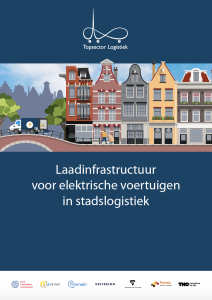Reducing GHG emissions requires smarter city logistics and zero-emission vehicles. Because the availability of electric vans and trucks is increasing rapidly, the electrification of freight to and from the city is obvious for companies. But electrification also raises questions for companies and the government.
How can transportation companies work with electric vehicles that need to be charged regularly? Which approach results in the lowest cost? Where, when and how quickly will delivery vans and trucks charge, and what is the impact on the electricity grid? The Dutch Top Sector Logistics has asked a group of experts to answer the questions. The result shows that there are already great opportunities for zero-emission city logistics.
Amsterdam
The Amsterdam Metropolitan region (NL) has been taken as an example. Amsterdam is implementing zero-emission city logistics in 2025. The research approach can be applied in other cities and regions: which choices will companies make in moving towards zero-emission city logistics? The approach is different for different segments: parcel deliveries to consumers have entirely different requirements than, for example, bringing perishables to retail stores, or supplying building materials to construction sites. Being able to deliver on time at the lowest costs is paramount in these transport choices. Understanding the individual choices provides insight into where, when and how quickly charging will take place. This allows network operators and municipalities to plan what infrastructure and space are needed for charging.
Great opportunities
The research shows that zero-emission city logistics offers great opportunities to companies. It is operationally and financially feasible, and as technology moves forward, the opportunities are only growing. In practice, the transition to zero-emission city logistics also proves to be the ideal moment for companies to organize logistics processes and planning in a different and smarter way. Trip data shows that for 90% of journeys today, the range and load capacity are no problem
The transition to zero-emission city logistics can often be done without additional large investments. Vehicles are more expensive but the operational costs (fuel, maintenance) are lower, which can be absorbed with smart financing of the electric fleet. Companies that now drive around in relatively cheap second-hand vans may require extra financial incentives. Today, there are no cheap second-hand electric vans available to them.
Charging is a regional issue
The extra demand for electricity is limited (only 2 to 3 percent extra demand), but locally the extra demand can be just too much for the grid: expanding capacity is sometimes necessary. Based on GIS-data it is easy to predict where charging will take place. For Greater Amsterdam, for example, the demand for public charging points in municipalities around Amsterdam can be predicted. The study found more than 90 percent of the trips electric vehicles going into the zero-emission zone make start in municipalities around Amsterdam. Charging is a regional issue.
For the Dutch providers of charging infrastructure and IT systems (TMS, planning, monitoring), electrical city logistics offers great opportunities: new products can be rolled out in the Netherlands that can then be offered to international markets.
Walther Ploos van Amstel.
Source: Topsector Logistics

